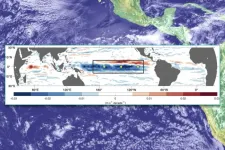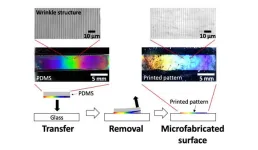(Press-News.org) A new study published October 31, 2024, in the Journal of Geophysical Research: Oceans has revealed significant acceleration in the upper-ocean circulation of the equatorial Pacific over the past 30 years. This acceleration is primarily driven by intensified atmospheric winds, leading to increased oceanic currents that are both stronger and shallower, with potential impacts on regional and global climate patterns, including the frequency and intensity of El Niño and La Niña events. The study provides a spatial view of these long-term trends from observations, adding at least another decade of data from previous studies.
The research team, led by Franz Philip Tuchen, a postdoctoral scientist at the University of Miami Rosenstiel School’s NOAA Cooperative Institute for Marine and Atmospheric Studies (CIMAS), in collaboration with NOAA’s Atlantic Oceanographic and Meteorological Laboratory (AOML), synthesized thirty years of long-term ocean and atmosphere observations from satellites, mooring buoys, and ocean surface drifters. By integrating the reanalysis of wind data and satellite altimetry into a high-resolution, gridded time series of near-surface ocean currents, this study presents a new and comprehensive view to date of the changes in the Pacific upper-ocean circulation.
The research findings indicate that stronger winds across the equatorial Pacific have caused a notable acceleration of westward near-surface currents by approximately 20 percent in the central equatorial Pacific. Poleward currents north and south of the equator have also accelerated, with increases of 60 percent and 20 percent, respectively.
“The equatorial thermocline—a critical ocean layer for El Niño–Southern Oscillation (ENSO) dynamics—has steepened significantly,” said Tuchen. “This steepening trend could reduce ENSO amplitude in the eastern Pacific and favor more frequent central Pacific El Niño events, potentially altering regional and global climate patterns associated with ENSO.”
The researchers indicate the study offers a benchmark for climate models, which have had limited success to accurately represent Pacific circulation and sea surface temperature trends. The researchers suggest the findings could help improve the predictability of ENSO events and related weather patterns, especially for regions like the United States, which experience significant climate variability from ENSO-driven changes.
Funding for this study was provided by NOAA’s Global Ocean Monitoring and Observing (GOMO) programs, including the Global Tropical Moored Buoy Array (GTMBA), the Global Drifter Program (GDP), and the Tropical Atmosphere Ocean (TAO) program.
The study, titled Strengthening of the equatorial Pacific upper-ocean circulation over the past three decades was published in the Journal of Geophysical Research: Oceans, on October 31, 2024. The authors include Franz Philip Tuchen1,2 Renellys C. Perez 2, Gregory R. Foltz2, Michael J. McPhaden3 and Rick Lumpkin2
1 Cooperative Institute for Marine and Atmospheric Studies, Rosenstiel School of Marine,
Atmospheric, and Earth Science, University of Miami, Miami, FL, USA
2 NOAA Atlantic Oceanographic and Meteorological Laboratory, Miami, FL, USA
3 NOAA Pacific Marine Environmental Laboratory, Seattle, WA, USA
About the University of Miami and Rosenstiel School of Marine, Atmospheric, and Earth Science
The University of Miami is a private research university and academic health system with a distinct geographic capacity to connect institutions, individuals, and ideas across the hemisphere and around the world. The University’s vibrant and diverse academic community comprises 12 schools and colleges serving more than 19,000 undergraduate and graduate students in more than 180 majors and programs. Located within one of the most dynamic and multicultural cities in the world, the University is building new bridges across geographic, cultural, and intellectual borders, bringing a passion for scholarly excellence, a spirit of innovation, a respect for including and elevating diverse voices, and a commitment to tackling the challenges facing our world. With more than $413 million in research and sponsored program expenditures annually, the University of Miami is a member of the prestigious Association of American Universities (AAU).
Founded in 1943, the Rosenstiel School of Marine, Atmospheric, and Earth Science is one of the world’s premier research institutions in the continental United States. The school’s basic and applied research programs seek to improve understanding and prediction of Earth’s geological, oceanic, and atmospheric systems by focusing on four key pillars:
*Saving lives through better forecasting of extreme weather and seismic events.
*Feeding the world by developing sustainable wild fisheries and aquaculture programs.
*Unlocking ocean secrets through research on climate, weather, energy and medicine.
*Preserving marine species, including endangered sharks and other fish, as well as protecting and restoring threatened coral reefs.
www.earth.miami.edu
END
Study reveals acceleration in Pacific upper-ocean circulation over past 30 years, impacting global weather patterns
A critical ocean layer for El Niño–Southern Oscillation (ENSO) dynamics
2024-10-31
ELSE PRESS RELEASES FROM THIS DATE:
Virginia Tech researcher finds AI could help improve city planning
2024-10-31
Traditional city planning methods require significant technical expertise and manual work.
A Virginia Tech researcher is working to change that.
New research shows the potential of large language models (LLMs), such as ChatGPT and Google’s Gemini, for assessing the human-made environment using street-view images.
By comparing LLM performance with traditional city planning deep learning methods, the study from the College of Natural Resources and Environment found that LLM-based performance is similar with established approaches. Unlike ...
A trick of light: UC Irvine researchers turn silicon into direct bandgap semiconductor
2024-10-31
Irvine, Calif., Oct. 31, 2024 — By creating a new way for light and matter to interact, researchers at the University of California, Irvine have enabled the manufacturing of ultrathin silicon solar cells that could help spread the energy-converting technology to a vast range of applications, including thermoelectric clothing and onboard vehicle and device charging.
The development, subject of a paper recently published as the cover story in the journal ACS Nano, hinges on the UC Irvine researchers’ conversion of pure silicon from an indirect to a direct bandgap semiconductor through the way it interacts ...
NIH trial of rectal microbicide for HIV prevention begins in the United States
2024-10-31
WHAT:
A clinical trial sponsored by the National Institutes of Health (NIH) has launched to examine the safety and acceptability of a novel rectal HIV microbicide douche containing the antiretroviral drug tenofovir. This “on-demand” HIV prevention approach involves using the microbicide prior to a potential exposure from receptive anal intercourse.
Several forms of HIV pre-exposure prophylaxis (PrEP) are in use in the United States and globally, namely daily oral pills, long-acting injections, and a monthly vaginal ring. The Centers for Disease Control and Prevention advises that gay, bisexual and other men who have sex with ...
Development of a simple, revolutionary printing technique for periodic nano/microstructures
2024-10-31
1. A team of researchers from NIMS and the University of Connecticut has developed a printing technique capable of forming a periodic nano/microstructure on the surface of a polydimethylsiloxane (PDMS) slab and easily transferring it onto the surface of a glass substrate. This technique enables us to create materials with useful functions—including water-repellency and the ability to generate structural colors—without expensive equipment and complex processes. In addition, the technique may be used to fabricate materials capable of realizing anti-fogging and/or generating structural colors on their surfaces—functions potentially useful in the development ...
Drug supply chain issues more likely to result in shortages in US than Canada
2024-10-31
Reports of drug-related supply-chain issues were 40% less likely to result in drug shortages in Canada versus the United States, according to a new study from University of Pittsburgh researchers and published today in JAMA.
The analysis looked at drugs that had reports of supply-chain disruptions between 2017 and 2021 in both countries and found that within 12 months of an initial U.S. report, nearly half resulted in drug shortages in the U.S. versus about one-third in Canada. There was also a consistently lower ...
Differences in Drug Shortages in the US and Canada
2024-10-31
About The Study: Drug-related reports of supply chain issues were 40% less likely to result in meaningful drug shortages in Canada compared with the U.S. These findings highlight the need for international cooperation between countries to curb the effects of drug shortages and improve resiliency of the supply chain for drugs.
Quote from corresponding author Katie J. Suda, PharmD, MS:
“Our U.S. drug supply chain is linked globally – shortages in one country can happen in another country – presenting an opportunity to compare and ...
Survival outcomes of an early intervention smoking cessation treatment after a cancer diagnosis
2024-10-31
About The Study: The results of this prospective cohort study suggest that evidence-based smoking cessation treatment within 6 months following a cancer diagnosis maximizes survival benefit. This study supports smoking cessation as an important early clinical intervention for patients after being diagnosed with cancer.
Corresponding Author: To contact the corresponding author, Paul M. Cinciripini, PhD, email pcinciri@mdanderson.org.
To access the embargoed study: Visit our For The Media website at this link ...
Quitting smoking after cancer diagnosis improves survival across a wide variety of cancers
2024-10-31
HOUSTON ― Smokers who are diagnosed with cancer now have more incentive to quit, as researchers from The University of Texas MD Anderson Cancer Center have found survival outcomes were optimized when patients quit smoking within six months of their diagnosis.
Study results, published today in JAMA Oncology, found a 22%-26% reduction in cancer-related mortality among those who had quit smoking within three months after tobacco treatment began. The best outcomes were observed in patients who started tobacco treatment within six months of a cancer diagnosis and were abstinent from smoking three months later. Survival for these patients increased from 2.1 years for ...
Genomic databases need more diversity
2024-10-31
CONTACT: Heide Aungst
HAungst@som.umaryland.edu
(216) 970-5773 (cell)
UNDER EMBARGO UNTIL 11 am on OCT. 31
Genomic Databases Need More Diversity
University of Maryland School of Medicine Researchers Create Large Database of Latin American Populations to Tackle Health Disparities
BALTIMORE, Oct. 31, 2024: It is commonly known that most genomic databases are biased toward people with European ancestry. Scientists have warned that leaving out other populations could skew results in areas such as drug development, ...
Biodiversity law that forces builders to compensate for nature loss could be twice as effective, experts claim
2024-10-31
Recent rules that require all new building and road projects in England to address and offset their impact on nature are excellent in principle but flawed in their implementation, leading environmental economists argue.
Under Biodiversity Net Gain (BNG), which became law this year, new building or infrastructure developments must achieve a 10% net gain in biodiversity or habitat.
In a new study published in One Earth, experts criticise the implementation of the policy which forces the majority of off-setting to occur within or near development sites rather than where it might most ...
LAST 30 PRESS RELEASES:
Scientists discover first method to safely back up quantum information
A role for orange pigments in birds and human redheads
Pathways to net-zero greenhouse gas emissions for Southeast Asia
A JBNU–KIMS collaborative study on a cost-effective alloy matches superalloys for power plants and energy infrastructure
New study overturns long-held model of how plants coordinate immune responses.
New AI model predicts disease risk while you sleep
Scientists discover molecular ‘reshuffle’ and crack an 80-year-old conundrum
How stressors during pregnancy impact the developing fetal brain
Electrons lag behind the nucleus
From fungi to brain cells: one scientist's winding path reveals how epigenomics shapes neural destiny
Schizophrenia and osteoporosis share 195 genetic loci, highlighting unexpected biological bridges between brain and bone
Schizophrenia-linked genetic variant renders key brain receptor completely unresponsive to both natural and therapeutic compounds
Innovative review reveals overlooked complexity in cellular energy sensor's dual roles in Alzheimer's disease
Autism research reframed: Why heterogeneity is the data, not the noise
Brazil's genetic treasure trove: supercentenarians reveal secrets of extreme human longevity
The (metabolic) cost of life
CFRI special issue call for papers: New Frontiers in Sustainable Finance
HKU Engineering scholar demonstrates the smallest all-printed infrared photodetectors to date
Precision empowerment for brain "eavesdropping": CAS team develops triple-electrode integrated functional electrode for simultaneous monitoring of neural signals and chemical transmitters during sleep
Single-capillary endothelial dysfunction resolved by optoacoustic mesoscopy
HKU three research projects named among ‘Top 10 Innovation & Technology News in Hong Kong 2025’ showcasing excellence in research and technology transfer
NLRSeek: A reannotation-based pipeline for mining missing NLR genes in sequenced genomes
A strand and whole genome duplication–aware collinear gene identification tool
Light storage in light cages: A revolutionary approach to on-chip quantum memories
Point spread function decoupling in computational fluorescence microscopy
BacPhase: Long-insert paired-end sequencing for bin marker construction and genome phasing
GmWOX1 regulates the mediolateral polarity of compound leaves in soybean
ChargeFabrica: An open-source simulation tool that aims to accelerate search for high performance perovskite solar cells
High levels of ADAR overexpression induce abundant and stochastic off-target RNA editing in rice protoplasts
On-demand upgraded recycling of polyethylene and construction of sustainable multifunctional materials based on the "LEGO" strategy
[Press-News.org] Study reveals acceleration in Pacific upper-ocean circulation over past 30 years, impacting global weather patternsA critical ocean layer for El Niño–Southern Oscillation (ENSO) dynamics





